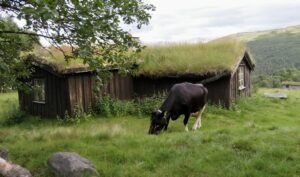
Exploring the Divine: Meet the Norse Goddess
Have you ever wondered about the gods and goddesses of the Scandinavian world? How did they shape the ancient Norse religion and mythology? Brace yourself for an enchanting journey as we delve into the captivating realm of Norse goddesses and their mesmerizing stories.
Uncover the mysteries of Norse mythology, where deities reigned supreme and mythical tales transported people to extraordinary realms. From the ethereal beauty of Freyja, the goddess of love and beauty, to the fearsome Valkyries who chose the fate of fallen warriors, each Norse goddess embodies power, strength, and deep symbolism.
Step into the world of Asgard, where gods resided in majestic halls, and explore the lesser-known Scandinavian goddesses whose fascinating stories reveal the rich tapestry of ancient beliefs. We will also trace their imprint in popular culture, where their legacy continues to thrive.
Join us as we unlock the secrets of the Norse goddesses, reclaiming their place in history and exploring the enduring appeal of their divine presence.
Table of Contents
ToggleKey Takeaways:
- Discover the enchanting world of Norse mythology and the beliefs of the ancient Norse people.
- Learn about the powerful Norse goddesses, including Freyja, the goddess of love and beauty.
- Uncover the role of the Valkyries, the mythical female figures who decided the fate of fallen warriors.
- Journey to Asgard, the celestial realm of the gods, and explore its significance in Norse mythology.
- Explore the lesser-known Scandinavian goddesses and their unique influence in Norse religion.
Origins of Norse Mythology
To fully understand the fascinating world of Norse mythology, it is essential to explore its origins and the ancient beliefs of the Norse people. Dating back to the pre-Christian era, Norse mythology is deeply rooted in the old Norse religion, which shaped the worldview and practices of the Scandinavian people.
The Norse people, who lived in what is now modern-day Scandinavia, relied heavily on oral tradition to pass down their myths and legends. These captivating tales were not only a source of entertainment but also served as a way to explain natural phenomena, societal values, and the complexities of the human experience.
At the heart of Norse mythology were the gods and goddesses who played significant roles in shaping the world and its inhabitants. These divine beings were revered and worshipped by the Norse people, who believed in their power to influence various aspects of life, from weather patterns to fertility and prosperity.
“The gods who emerged from Old Norse religion formed a complex pantheon, each with unique attributes and responsibilities. They were revered as powerful and often fallible beings, mirroring human qualities and experiences.”
The gods and goddesses of Norse mythology inhabited a realm known as Asgard, a celestial realm that was seen as the center of their cosmos. Asgard was the dwelling place of the gods and served as the stage for many mythical tales and adventures.
As the belief system evolved over time, Norse mythology became intertwined with the historical events and cultural developments of the Norse people. The stories of gods and goddesses often reflected the challenges and triumphs of the society, serving as both a source of inspiration and a reminder of their own mortality.
Throughout the ages, Norse mythology has captivated the imagination of people worldwide. Its enduring appeal can be seen in various forms of popular culture, from books and movies to video games and artwork. The rich tapestry of Norse mythology continues to fascinate and inspire, offering us a glimpse into the ancient beliefs and practices of the Norse people.
Freyja: The Goddess of Love and Beauty
Embark on a journey into the enchanting realm of Norse mythology as we delve into the captivating tale of Freyja, the Norse goddess of love, beauty, and fertility. With her irresistible charm and captivating presence, Freyja holds a prominent role in the pantheon of Norse deities.
Often described as the most beautiful of all goddesses in Norse mythology, Freyja exudes a radiant aura that captures the hearts of all who encounter her. Her name itself translates to “lady” or “noble woman,” reflecting her graceful presence and esteemed position among the gods and goddesses.
As the goddess of love, Freyja governs matters of the heart, inspiring desire, passion, and romantic connections. She possesses a unique ability to bring people together, fostering deep and meaningful relationships. Her influence extends beyond romantic love, encompassing familial bonds and friendships as well.
Furthermore, Freyja’s association with beauty is not solely confined to physical appearance. She embodies inner radiance, emphasizing the importance of self-love, self-expression, and embracing one’s individuality. Her enchanting allure serves as a reminder that true beauty emanates from within.
Among Freyja’s many powers is her connection to fertility and abundance. As the goddess of fertility, she bestows blessings upon those seeking to conceive and ensures the prosperity of the land. Farmers and crops alike are under her watchful eye, as she oversees the growth and abundance of the natural world.
Freyja’s association with the divine realm of folkvangr further reinforces her influential position. This heavenly realm serves as a sanctuary for fallen warriors, handpicked by Freyja herself. In her role as the leader of the Valkyries, she guides the valiant souls to their eternal resting place, where they are honored for their bravery and heroism.
“Freyja, radiant goddess of love and beauty, weaves tales of passion and enchantment throughout Norse mythology. Her presence illuminates the divine realms, and her gentle touch inspires love in all its forms.”
With her multifaceted nature, Freyja embodies the complexity of human emotions, representing both love’s tender embrace and its fierce intensity. She stands as a symbol of empowerment and liberation, encouraging individuals to embrace their hearts’ desires and grow in self-discovery.
As we continue our exploration of Norse mythology, the tale of Freyja serves as a reminder of the enduring allure and significance of the Norse goddesses. From their captivating powers and associations to their timeless stories, these divine beings continue to captivate and inspire us.
| Attributes | Associations | Symbols |
|---|---|---|
| Love | Beauty | Necklace Brísingamen |
| Fertility | Abundance | Cats |
| Passion | Creativity | Swans |
Valkyries: The Choosers of the Slain
The Valkyries, revered figures in Norse mythology, were divine servants of Odin, the Allfather. These extraordinary female beings played a crucial role in the fate of fallen warriors, shaping the outcome of battles and determining who would enter the realm of Valhalla.
In Norse mythology, the Valkyries were responsible for selecting the brave warriors who would be granted a place in Valhalla, the glorious hall of the fallen in Asgard. They would descend onto battlefields, clad in armor and mounted on swift horses, to choose the most courageous heroes among the fallen.
Legend has it that the Valkyries possessed the ability to fly over the battlefield, handpicking the souls of fallen fighters. Their keen discernment allowed them to choose those warriors who displayed exceptional bravery, valor, and skill in combat.
Once selected, the chosen warriors would be escorted to Valhalla by the Valkyries, where they would join Odin and other esteemed gods and goddesses in eternal feasting, camaraderie, and preparation for the great battle of Ragnarok.
The Valkyries were revered as symbols of both death and rebirth, embodying the duality of war and the warrior’s journey. They were fierce and powerful, embodying the characteristics of relentless warriors themselves.
In Norse mythology, the Valkyries were often depicted as shield-maidens, skilled in combat and armed with swords or spears. They were also associated with ravens, with several myths suggesting that they could transform into these magnificent birds.
The Valkyries’ significance extended beyond their role as divine warriors. They were also believed to have healing powers, attending to wounded warriors and revitalizing them with their mystic abilities. The representation of the Valkyries as both warrior and healer further highlights their multifaceted nature and divine capabilities.
“The Valkyries, with their unique blend of strength and compassion, were enigmatic figures in Norse mythology and held immense influence over the lives and deaths of warriors. Their role as the Choosers of the Slain continues to captivate audiences and speaks to the intricate tapestry of honor, fate, and battle embedded in Norse mythology.”
The Role of Valkyries in Norse Mythology
The Valkyries acted as intermediaries between the mortal realm and the gods, carrying out the will of Odin and determining the fate of fallen warriors. Their selection process was based on not just martial prowess but also the hero’s character, integrity, and loyalty.
By bringing the chosen warriors to Valhalla, the Valkyries ensured that Asgard’s army of the fallen would be ready for the final battle during Ragnarok. Their role as the Choosers of the Slain had a significant impact on Norse society, inspiring warriors to seek glory and honor in battle, knowing that their bravery and valor could be rewarded with a place among the gods.
The Valkyries, in their divine form, embodied the ideals of Norse society: courage, self-sacrifice, and determination. Their presence in mythology serves as a reminder of the profound influence these legendary figures had on the collective psyche of the Norse people.
| Key Attributes of Valkyries | Significance in Norse Mythology |
|---|---|
| Warrior-like prowess | The Valkyries embodied the warrior spirit and served as an inspiration for mortal warriors. |
| Guided fallen warriors to Valhalla | They determined the fate of slain warriors, granting them eternal honor in Valhalla. |
| Healing abilities | They possessed the power to heal and revive fallen warriors, symbolizing rebirth. |
| Intermediaries between mortals and gods | The Valkyries acted as messengers of the gods and carried out the will of Odin. |
Asgard: The Realm of the Gods
Journey to Asgard, the celestial realm of the Norse gods and goddesses. Asgard is a majestic and mythical realm that holds immense significance in Norse mythology. It is the home of the Aesir, the principal group of gods, led by the mighty Odin. Situated high above the mortal world, Asgard is a realm of extraordinary beauty and power.
Norse mythology portrays Asgard as a place of grandeur, filled with magnificent halls and towering palaces. The most renowned and majestic of these is Valhalla, the great hall where fallen warriors are taken by the Valkyries. Here, the brave warriors enjoy endless feasting and prepare for the final battle of Ragnarok.
Asgard is also the dwelling place of other prominent gods and goddesses. Thor, the god of thunder, resides in his mighty hall, Thrudheim. Freyja, the goddess of love and beauty, has her own sacred abode called Sessrumnir. Other deities, such as Tyr, Heimdall, and Baldr, also have homes within the realm of Asgard.
Norse mythology’s portrayal of Asgard reflects the power dynamics and hierarchy within the realm. It is a place where gods and goddesses govern, protect, and interact with the mortal world. Asgard acts as a bridge connecting the divine and mortal realms, allowing for the exchange of knowledge, goods, and even battles.
The significance of Asgard extends beyond its physical beauty and divine inhabitants. It symbolizes the aspirations and ideals of the Norse people, representing a realm where justice, honor, and bravery prevail. Asgard serves as the embodiment of Norse mythology’s core values and beliefs, reflecting the eternal struggle between order and chaos, good and evil.
Deities of Asgard
| Deity | Domain |
|---|---|
| Odin | Wisdom, war, poetry |
| Thor | Thunder, strength, protection |
| Freyja | Love, beauty, fertility |
| Tyr | Justice, law, courage |
| Baldr | Light, purity |
| Heimdall | Guardian, watchman |
Asgard continues to capture the imagination of people worldwide through its portrayal in various forms of media and popular culture. From books and movies to video games and artwork, the allure of Asgard and its gods and goddesses remain strong, captivating audiences with tales of heroism, adventure, and divine power.
Lesser-Known Scandinavian Goddesses
As we explore the rich tapestry of Norse mythology, it is impossible to overlook the captivating tales of the well-known Norse goddesses such as Freyja and Frigg. However, there is a whole pantheon of lesser-known Scandinavian goddesses who deserve recognition for their unique powers, stories, and influence within the realms of Norse religion.
One such goddess is Eir, the goddess of healing. Revered for her immense knowledge of medicinal herbs and remedies, Eir was often called upon to aid the wounded and provide comfort to those in need. Her presence brings a sense of hope and restoration, making her a beloved figure in the hearts of many.
Another lesser-known goddess is Sif, the goddess of fertility and the harvest. With her flowing golden hair, Sif represents the bountiful abundance of the earth. She ensures the fertility of crops, ensuring prosperous harvests and nourishment for the community. Sif’s gentle touch and nurturing nature make her an essential deity in agricultural communities.
The Power of Skadi
Skadi, the goddess of winter and mountains, holds sway over the harsh snowy landscapes that define the Scandinavian region. With her graceful yet unyielding presence, Skadi commands both the beauty and the challenges of winter. She is a symbol of resilience and adaptability, reminding us of the strength required to endure the harshest of conditions.
Skadi’s mythology is closely tied to her marriage to Niord, the sea god. Their union bridges the divide between the frosty mountains and the vast ocean, highlighting the interconnectedness of the natural world in Norse mythology.
One of the most intriguing goddesses is Ran, the goddess of the sea. As the mistress of the watery depths, Ran holds dominion over the treasures and mysteries that lie beneath the waves. Sailors and fishermen would pay homage to her, seeking her favor and protection during their perilous journeys. Ran’s fierce and unpredictable nature serves as a reminder of the vastness and power of the sea.
These are just a few examples of the lesser-known Scandinavian goddesses that add depth and complexity to the vast tapestry of Norse mythology. Each goddess brings her own unique powers and stories, enriching the pantheon of Norse deities and capturing the imagination with their distinct qualities and influences.
As we continue our journey through the wonders of Norse mythology, let us not overlook these often overshadowed goddesses. For in their stories, we find hidden gems of wisdom, strength, and beauty that deserve to be celebrated and cherished.
Norse Goddesses in Popular Culture
Throughout the centuries, the powerful and enchanting Norse goddesses have not only captivated ancient civilizations but continue to be revered and celebrated in popular culture today. Their rich mythology and compelling stories have found their way into literature, movies, art, and various other forms of media, bringing these divine beings to life in vivid detail.
One of the most iconic representations of Norse goddesses can be found in literature, where their captivating stories have inspired countless authors. From Neil Gaiman’s critically acclaimed novel “American Gods” to Joanne Harris’ enchanting tale “The Gospel of Loki,” these authors have skillfully woven the intricate tapestry of Norse mythology, with Norse goddesses prominently featured as key characters.
Movies and television series have also embraced the allure of Norse goddesses, bringing them to the silver screen with stunning visuals and captivating narratives. In the Marvel Cinematic Universe, the character of Freyja, the Norse goddess of love and beauty, has been portrayed in the Thor films, played by renowned actress Rene Russo. These adaptations have brought the essence of the Norse goddesses to a global audience, further immortalizing their presence in popular culture.
The influence of Norse goddesses extends beyond literature and cinema, making its way into the world of art and design. Artists have drawn inspiration from the beauty and power of these divine entities, creating stunning illustrations, sculptures, and jewelry that pay tribute to the Norse mythology and its legendary goddesses. The iconic symbols associated with Norse goddesses, such as Freyja’s necklace Brísingamen or the valkyrie’s winged helmet, have become widely recognized motifs in contemporary art and fashion.
Furthermore, the popularity of Norse goddesses has extended into the realm of video games. Characters inspired by these powerful beings can be found in various interactive adventures, where players can immerse themselves in the captivating world of Norse mythology and experience firsthand the awe-inspiring powers of the goddesses.
“The enduring legacy of Norse goddesses in popular culture is a testament to their timeless allure and the lasting impact of Norse mythology. From literature and movies to art and video games, these powerful beings continue to capture our imagination and inspire us with their strength, beauty, and captivating stories.”
Conclusion
In conclusion, our exploration of Norse goddesses has taken us on a captivating journey into the realms of Norse mythology and ancient Scandinavian beliefs. We have encountered a diverse cast of divine figures, each with their own unique powers, stories, and significance. From Freyja, the goddess of love and beauty, to the Valkyries, the fierce choosers of the slain, these goddesses have left an indelible mark on Norse culture and continue to enchant and inspire us today.
The enduring appeal of Norse goddesses lies in their multifaceted nature. They embody a range of qualities, from compassion and love to strength and wisdom. They represent the forces of nature, fertility, war, and the cosmos, making them complex and relatable figures that resonate with people from all walks of life.
Furthermore, Norse mythology and its divine female figures have found their way into popular culture, allowing us to encounter these goddesses in various forms. From literature to movies and even video games, the influence of Norse goddesses can be seen across different media, further fueling our fascination and keeping their stories alive.
FAQ
What is Norse mythology?
Who were the Norse goddesses?
Who was Freyja?
What were the Valkyries?
What is Asgard?
Who were the lesser-known Scandinavian goddesses?
How have Norse goddesses influenced popular culture?
If you want to learn Norwegian, you can register for classes here. We look forward to hearing from you and helping you become fluent in Norwegian.





